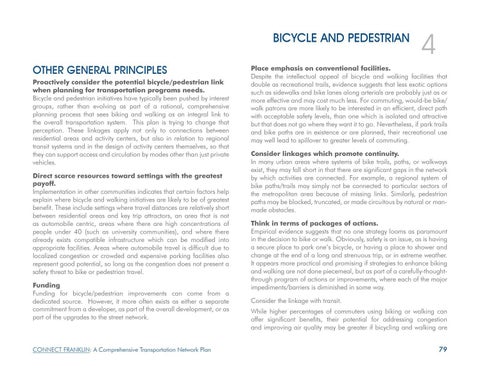BICYCLE AND PEDESTRIAN OTHER GENERAL PRINCIPLES Proactively consider the potential bicycle/pedestrian link when planning for transportation programs needs. Bicycle and pedestrian initiatives have typically been pushed by interest groups, rather than evolving as part of a rational, comprehensive planning process that sees biking and walking as an integral link to the overall transportation system. This plan is trying to change that perception. These linkages apply not only to connections between residential areas and activity centers, but also in relation to regional transit systems and in the design of activity centers themselves, so that they can support access and circulation by modes other than just private vehicles. Direct scarce resources toward settings with the greatest payoff. Implementation in other communities indicates that certain factors help explain where bicycle and walking initiatives are likely to be of greatest benefit. These include settings where travel distances are relatively short between residential areas and key trip attractors, an area that is not as automobile centric, areas where there are high concentrations of people under 40 (such as university communities), and where there already exists compatible infrastructure which can be modified into appropriate facilities. Areas where automobile travel is difficult due to localized congestion or crowded and expensive parking facilities also represent good potential, so long as the congestion does not present a safety threat to bike or pedestrian travel. Funding Funding for bicycle/pedestrian improvements can come from a dedicated source. However, it more often exists as either a separate commitment from a developer, as part of the overall development, or as part of the upgrades to the street network.
CONNECT FRANKLIN: A Comprehensive Transportation Network Plan
4
Place emphasis on conventional facilities. Despite the intellectual appeal of bicycle and walking facilities that double as recreational trails, evidence suggests that less exotic options such as sidewalks and bike lanes along arterials are probably just as or more effective and may cost much less. For commuting, would-be bike/ walk patrons are more likely to be interested in an efficient, direct path with acceptable safety levels, than one which is isolated and attractive but that does not go where they want it to go. Nevertheless, if park trails and bike paths are in existence or are planned, their recreational use may well lead to spillover to greater levels of commuting. Consider linkages which promote continuity. In many urban areas where systems of bike trails, paths, or walkways exist, they may fall short in that there are significant gaps in the network by which activities are connected. For example, a regional system of bike paths/trails may simply not be connected to particular sectors of the metropolitan area because of missing links. Similarly, pedestrian paths may be blocked, truncated, or made circuitous by natural or manmade obstacles. Think in terms of packages of actions. Empirical evidence suggests that no one strategy looms as paramount in the decision to bike or walk. Obviously, safety is an issue, as is having a secure place to park one’s bicycle, or having a place to shower and change at the end of a long and strenuous trip, or in extreme weather. It appears more practical and promising if strategies to enhance biking and walking are not done piecemeal, but as part of a carefully-thoughtthrough program of actions or improvements, where each of the major impediments/barriers is diminished in some way. Consider the linkage with transit. While higher percentages of commuters using biking or walking can offer significant benefits, their potential for addressing congestion and improving air quality may be greater if bicycling and walking are
79









